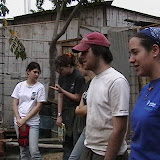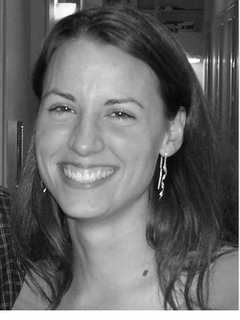
The "muñecos", or dolls, as they are referred to here, are made in the shape of famous people, cartoon characters, politicians, athletes... or yourself, family and friends!
Here Yana, from the University of Chicago Global Village group which built in Guayaquil, holds the hand of Ecuador´s newly inaugurated "President Correa." (the other guy , Naboa, won in Guayaquil) This particular muñeco is small in comparison to many others I saw during the next few days!
James flew into Guayaquil to spend New Years with me, and after we spent about a day there we traveled to the coast. We began in a small fishing-tourist village called "Puerto Lopez" (also the departure point for "Isla de la Plata", see post on Blue Footed Boobies- Prelude to Galapagos).
On the way out of town we witnessed many muñecos being transported out of the city for peoples New Years Celebrations. Here is the Incredible Hulk, tied to someones truck!
 The idea of the dolls in the shape of politicians and sports celebrities is that you get to burn a team that you don´t like, or a political figure... I didn´t really get the idea of burning the super heroes! I think James and I saw ... at least 5 or 6 Supermen. Here is the "squirrel " character from the Ice Age movie.
The idea of the dolls in the shape of politicians and sports celebrities is that you get to burn a team that you don´t like, or a political figure... I didn´t really get the idea of burning the super heroes! I think James and I saw ... at least 5 or 6 Supermen. Here is the "squirrel " character from the Ice Age movie.  This particular muñeco was driven all over town many times even though Puerto Lopez was his final destination. It seemed as the time grew near for their incineration, the dolls were moved to more prominent locations or taken for a spin!..
This particular muñeco was driven all over town many times even though Puerto Lopez was his final destination. It seemed as the time grew near for their incineration, the dolls were moved to more prominent locations or taken for a spin!..So, for those interested in making their own muñeco... and I considered it, you only have to worry about making the body (that is, if you are sticking to human forms). That is because your local stores are tuned into head salesmen!
 For all those head-hunters out there. Here is James hanging out with the selection of heads on the "main road in Puerto Lopez. The heads seem rather pink don´t they?
For all those head-hunters out there. Here is James hanging out with the selection of heads on the "main road in Puerto Lopez. The heads seem rather pink don´t they? So, the kind of doll that was made to look like you, or your family or other local people had a different context. Usually these dolls were accompanied with long written explanations of things that had happened in the last year that were lamentable, or that a person was pledging to not have happen again.
So, the kind of doll that was made to look like you, or your family or other local people had a different context. Usually these dolls were accompanied with long written explanations of things that had happened in the last year that were lamentable, or that a person was pledging to not have happen again.  Many times the statements included inside jokes and references to very confusing instances...
Many times the statements included inside jokes and references to very confusing instances...Here I am with a neighbor boy and his family´s group of four muñecos, playing cards.

Muñecos representing US President Bush and Vice President Cheney were burned by the most popular hostel on the Puerto Lopez coast. They were displayed holding weapons at the hostel entrance until close to midnight when they were taken to the beach for a bonfire.
James and I tried to bring in the New Year 2007 with an Ecuadorian Champagne... however when we went to "release" the celebratory cork... all pressure had long since dissipated! this did not damper our spirits however, we quickly recovered from the comic disappointment and got in some dancing at the local block parties:-).


 They sleep on land and hunt in the ocean. They are great divers and can swim distances if necessary. Usually the iguanas are scavengers and vegetarians, however one was recently documented actually attacking and killing a live octopus!
They sleep on land and hunt in the ocean. They are great divers and can swim distances if necessary. Usually the iguanas are scavengers and vegetarians, however one was recently documented actually attacking and killing a live octopus! Here is a close-up of a marine iguana.
Here is a close-up of a marine iguana.


 The penguin is at great risk of going extinct, however as during the last, "El Niño" year, the populations dwindled and would not survive another if they are affected in the same way.
The penguin is at great risk of going extinct, however as during the last, "El Niño" year, the populations dwindled and would not survive another if they are affected in the same way. 


 Some of the other birds we witnessed were albatross (below), which was completing its mating season....
Some of the other birds we witnessed were albatross (below), which was completing its mating season.... and masked boobies.
and masked boobies. Here is a cactus that has grown a trunk to protect it from the land iguanas. Interestingly, only a sterile hybrid, a cross between the marine iguanas and the land iguanas, which only occurs on one of the Galapagos Islands, is able to climb the cactus! You can tell the hybrid is present when the cacti has bites out of its... and they haven't yet fallen to the ground.
Here is a cactus that has grown a trunk to protect it from the land iguanas. Interestingly, only a sterile hybrid, a cross between the marine iguanas and the land iguanas, which only occurs on one of the Galapagos Islands, is able to climb the cactus! You can tell the hybrid is present when the cacti has bites out of its... and they haven't yet fallen to the ground.
 The land iguana will wait months for this to happen! In the meantime they also eat other vegetation and other pieces of cactus.
The land iguana will wait months for this to happen! In the meantime they also eat other vegetation and other pieces of cactus. Here is a close-up of the red ground cover.
Here is a close-up of the red ground cover.
 The baby turtles are maintained separate based on their island of origin because the tortoise species has now differentiated into distinct sub-species. The tortoises were in need of a breeding program after feral goats had eaten much of their food sources. The Galapagos National Park now has feral goat eradication programs underway, and some have been completed.
The baby turtles are maintained separate based on their island of origin because the tortoise species has now differentiated into distinct sub-species. The tortoises were in need of a breeding program after feral goats had eaten much of their food sources. The Galapagos National Park now has feral goat eradication programs underway, and some have been completed. There is a huge financial reward being offered for anyone who can locate another of his kind. During the early 1900s, tortoises were removed from the Galapagos and sold all over the world as a kind of unique lawn ornament. So far no one has come forward with a mate for George. The center is trying to breed him with the most similar sub-species that exists, but George is not interested.
There is a huge financial reward being offered for anyone who can locate another of his kind. During the early 1900s, tortoises were removed from the Galapagos and sold all over the world as a kind of unique lawn ornament. So far no one has come forward with a mate for George. The center is trying to breed him with the most similar sub-species that exists, but George is not interested. She is working for a Swedish agency which provides an international presence to non-governmental organizations in Colombia.
She is working for a Swedish agency which provides an international presence to non-governmental organizations in Colombia.  They brought a small Christmas tree and some other decorations, and gifts for each other and demanded that the cook make something special for Christmas dinner. Above they are posing with their Christmas tree. The girls did not stop their complaints and demands at Christmas- They were upset that the English/Spanish speaking guide didn't know the names of seabirds in German, didn't want to hike some of the island trails, and their opinion of the boat was very low... they couldn't imagine how 10 people could fit on such a boat.
They brought a small Christmas tree and some other decorations, and gifts for each other and demanded that the cook make something special for Christmas dinner. Above they are posing with their Christmas tree. The girls did not stop their complaints and demands at Christmas- They were upset that the English/Spanish speaking guide didn't know the names of seabirds in German, didn't want to hike some of the island trails, and their opinion of the boat was very low... they couldn't imagine how 10 people could fit on such a boat.



 Above are pictured a view from Las Peñas and the "Malecon 2000", which is the renovated boardwalk which was completed in 2000.
Above are pictured a view from Las Peñas and the "Malecon 2000", which is the renovated boardwalk which was completed in 2000. 



 These houses were the standard 6m by 6m by 6m design currently being built by Habitat in Ecuador. Once the family pays off 80 percent of the no-interest loan, they are eligible for some additional floor space and bigger loan.
These houses were the standard 6m by 6m by 6m design currently being built by Habitat in Ecuador. Once the family pays off 80 percent of the no-interest loan, they are eligible for some additional floor space and bigger loan.



 Since U. of Chicago's visit, both John Hopkins University and University of North Carolina have arrived in Ecuador with Global Village teams as well!- I was not able to travel with either of these teams however, as I was with another Global Village teams or out of the country.
Since U. of Chicago's visit, both John Hopkins University and University of North Carolina have arrived in Ecuador with Global Village teams as well!- I was not able to travel with either of these teams however, as I was with another Global Village teams or out of the country.